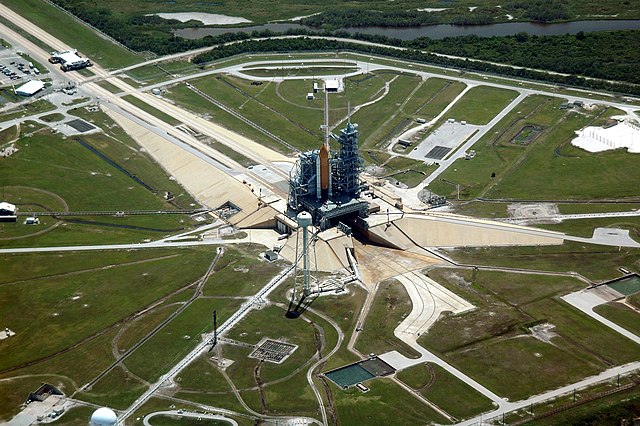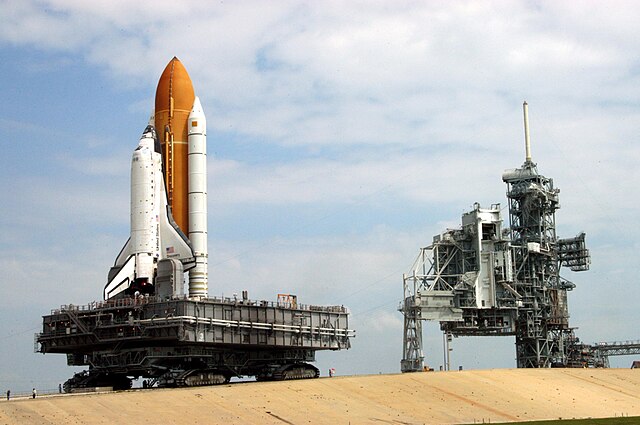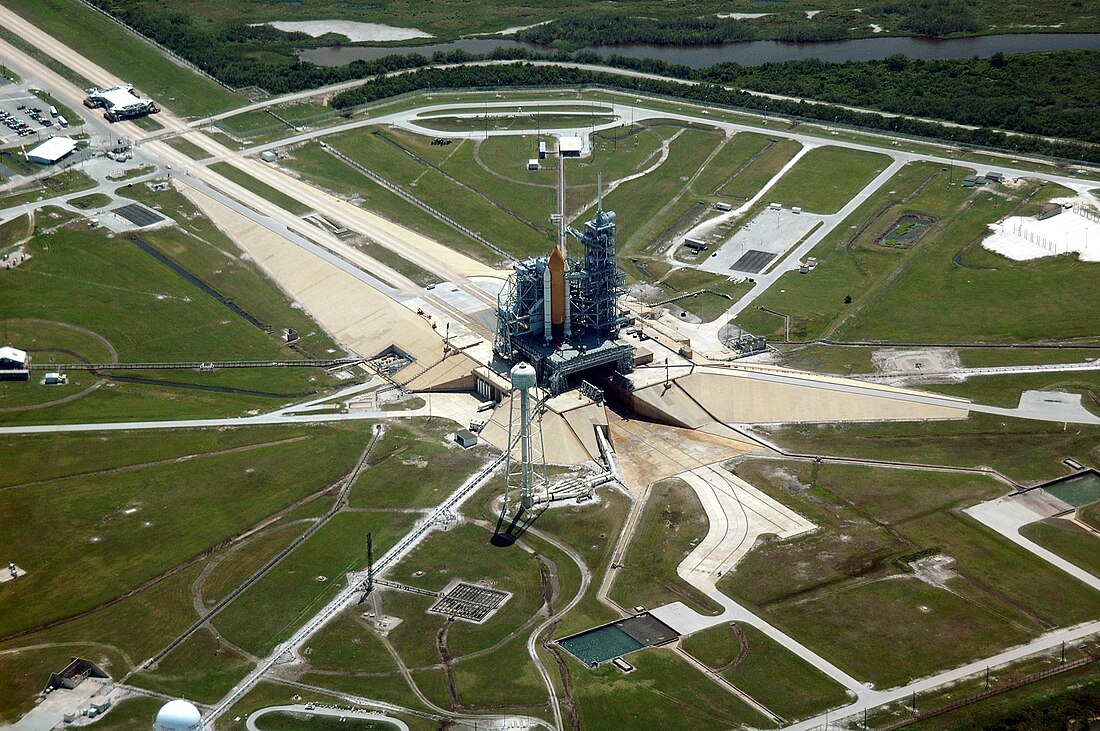发射台
火箭发射设施 来自维基百科,自由的百科全书
发射台是一种设计为发射火箭能驱动飞行器的地面设施(包括运载火箭、航天飞机、弹道导弹等在内)[1],可用于固定和支撑火箭并为火箭和载荷提供维护支持。发射台大致可分为固定式发射台和移动式发射台,其中移动式发射台可以在公路或铁路上进行移动[2]。
此条目目前正依照其他维基百科上的内容进行翻译。 (2023年8月15日) |

大多数发射台都包括固定的服务结构,以提供一个或多个进入平台来组装、检查和维护运载工具,并允许进入航天器,包括装载机组人员。 该垫可以包含火焰偏转结构,以防止火箭排气的强热损坏飞行器或垫结构,并且可以采用喷洒大量水的声音抑制系统。 该垫也可以受到避雷器的保护。 航天发射场通常包括多个发射场和其他支持基础设施。
已隐藏部分未翻译内容,欢迎参与翻译。
Most launch pads include fixed service structures to provide one or more access platforms to assemble, inspect, and maintain the vehicle and to allow access to the spacecraft, including the loading of crew. The pad may contain a flame deflection structure to prevent the intense heat of the rocket exhaust from damaging the vehicle or pad structures, and a sound suppression system spraying large quantities of water may be employed. The pad may also be protected by lightning arresters. A spaceport typically includes multiple launch complexes and other supporting infrastructure.
The launch complex for liquid fueled rockets often has extensive ground support equipment including propellant tanks and plumbing to fill the rocket before launch. Cryogenic propellants (liquid oxygen oxidizer, and liquid hydrogen or liquid methane fuel) need to be continuously topped off (i.e., boil-off replaced) during the launch sequence (countdown), as the vehicle awaits liftoff. This becomes particularly important as complex sequences may be interrupted by planned or unplanned holds to fix problems.
Most rockets need to be supported and held down for a few seconds after ignition while the engines build up to full thrust. The vehicle is commonly held on the pad by hold-down arms or explosive bolts, which are triggered when the vehicle is stable and ready to fly, at which point all umbilical connections with the pad are released.
Transport of rockets to the pad
此section可能包含原创研究。 (2018年11月1日) |



Each launch site is unique, but a few broad types can be described by the means by which the space vehicle gets to the pad.[来源请求]
- Horizontally integrated rockets travel horizontally with the tail forward to the launch site on a transporter erector launcher and are then raised to the vertical position over the flame duct. Examples include all large Soviet rockets, including Soyuz, Proton, N1, and Energia. This method is also used by the SpaceX and Electron launch vehicles.
- Silo launched rockets are assembled inside of a missile silo. This method is only used by converted ICBMs due to the difficulty and expense of constructing a silo that can contain the forces of a rocket launch.
- Vertically integrated rockets can be assembled in a separate hangar on a mobile launcher platform (MLP). The MLP contains the umbilical structure and is carried to the launch site on a large vehicle called Crawler-transporter. Launch Complex 39 at the Kennedy Space Center is an example of a facility using this method.[3] A similar system is used to launch Ariane 5 rockets at ELA-3 at Guiana Space Centre.
- Vertically assembled vehicles can also be transported on a mobile launcher platform resting on two parallel standard gauge railroad tracks that run from the integration building to launch area. This system is still in use for the Atlas V and future Vulcan.
- At SLC-6 and SLC-37, rockets are assembled on the launch mount. A windowless rail-mounted building encloses the launch pad and gantry to protect the vehicle from the elements, and for purposes of military secrecy. Prior to launch,[4] the building is rolled away. This method is also used at Kagoshima for the M-V.
- The former Sea Launch service used the converted self-propelled oil drilling platform Ocean Odyssey to transport Zenit 3SL rockets horizontally to the Equator, and then to erect and launch them from a floating launch platform into geostationary transfer orbits.
发射台的类型
其中综合发射系统通常包括一个用于支撑火箭的发射架或发射平台(即狭义上的“发射台”)、一个带有脐带缆的服务结构(通称“脐带塔”),以及一套用于提供推进剂、电力、通信、遥测、散热、火箭组装、有效载荷处理和存储设施所需的勤务设施(通称“勤务塔”)[5],而以上所述的各个结构在实际设计时其功能可能会被合并至同一个建筑中去(如921发射工位的发射塔架便集成了勤务塔和脐带塔的功能[6])。
参见
- Ground segment——火箭发射设施
- Launch vehicle——火箭发射设施
- List of rocket launch sites
- Missile launch facility
- Non-rocket spacelaunch
- Pad abort test——火箭发射设施
- Rocket launch
- Service structure——火箭发射设施
- Spaceport
- Stratolaunch Systems——火箭发射设施
- Transporter erector launcher——火箭发射设施
参考文献
Wikiwand - on
Seamless Wikipedia browsing. On steroids.
